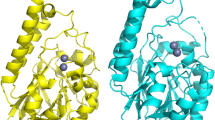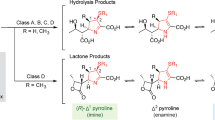Abstract
The rampant use and misuse of antibiotics in human medicine, agriculture and veterinary have become the key contributors to global antimicrobial resistance. One of the significant resistance mechanisms that inactivates antibiotics and impedes treatment of bacterial infections is the expression of β-lactamases. Rising evidence of newer variants of β-lactamases in the environment is therefore a serious threat to the presently available antibiotic armoury. The present work describes the purification of a variant β-lactamase isolated from a soil strain EMB20 of Bacillus cereus. The lactamase was purified using three-phase partitioning and gel filtration chromatography to a 30-fold purification and 15% recovery yield. Contrary to the general trend, the lactamase was not a metalloenzyme, but its activity was enhanced in the presence of Mg2+ and Mn2+. The EMB20 lactamase exhibited improved stability against inhibitors and denaturing agents such as urea and GdmCl as compared to its commercial analogue. The improved stability of EMB20 lactamase was further validated by circular dichroism and fluorescence spectroscopy. This study reemphasizes the rising prevalence of environmental lactamase variants. Decoding the structure–function correlation of such lactamases in the presence of inhibitors will provide insights into the response of this enzyme towards inhibitors as well as its substrates.






Similar content being viewed by others
References
O’Neill, J. (2016). Tackling drug-resistant infections globally: final report and recommendations. The review on antimicrobial resistance. London: HM Government and the Wellcome Trust.
Chen, J., Chen, H., Shi, Y., Hu, F., Lao, X., Gao, X., Zheng, H., & Yao, W. (2013). Probing the effect of the non-active-site mutation Y229W in New Delhi metallo-β-lactamase-1 by site-directed mutagenesis, kinetic studies, and molecular dynamics simulations. PloS One, 8, 1–8.
Eze, U. A., Eze, N. M., & Mustapha, A. (2015). Enzymatic inactivation of penicillins: an emerging threat to global public health. International Journal of Pharmaceutical Sciences and Research, 6, 3151–3160.
Rawat, D., & Nair, D. (2010). Extended-spectrum ß-lactamases in gram negative bacteria. Journal of Global Infectious Diseases, 2, 263–274.
Zeng, X., & Lin, J. (2013). Beta-lactamase induction and cell wall metabolism in gram-negative bacteria. Frontiers in Microbiology, 4, 1–9.
Castanheira, M., Farrell, S. E., Krause, K. M., Jones, R. N., & Sader, H. S. (2014). Contemporary diversity of beta-lactamases among Enterobacteriaceae in the nine U.S. census regions and ceftazidime-avibactam activity tested against isolates producing the most prevalent beta-lactamase groups. Antimicrobial Agents and Chemotherapy, 58, 833–838.
Tajbakhsh, M., Avini, M. Y., Alikhajeh, J., Tajeddin, E., Rahbar, M., Eslami, P., Alebouyeh, M., & Zali, M. R. (2016). Emergence of blaCTX-M-15, blaTEM-169 and blaPER-1 extended-spectrum beta-lactamase genes among different Salmonella enterica serovars from human faecal samples. Infectious Diseases, 48, 550–556.
Thomas, P. W., Zheng, M., Wu, S., Guo, H., Liu, D., Xu, D., & Fast, W. (2011). Characterization of purified New Delhi metallo-β-lactamase-1. Biochemistry, 50, 10102–10113.
Schlesinger, S. R., Kim, S. G., Lee, J.-S., & Kim, S.-K. (2011). Purification development and characterization of the zinc-dependent metallo-β-lactamase from Bacillus anthracis. Biotechnology Letters, 33, 1417–1422.
D’Angelo, R. G., Johnson, J. K., Bork, J. T., & Heil, E. L. (2016). Treatment options for extended-spectrum beta-lactamase (ESBL) and AmpC-producing bacteria. Expert Opinion on Pharmacotherapy, 17, 953–967.
Verma, D., Jacobs, D. J., & Livesay, D. R. (2013). Variations within class-A beta-lactamase physiochemical properties reflect evolutionary and environmental patterns, but not antibiotic specificity. PLoS Computational Biology, 9, e1003155.
Brown, M. C., Verma, D., Russell, C., Jacobs, D. J., & Livesay, D. R. (2014). A case study comparing quantitative stability-flexibility relationships across five metallo-beta-lactamases highlighting differences within NDM-1. Methods in molecular biology (Clifton, N.J.), 1084, 227–238.
Shanthi, J., Senthil, A., Gopikrishnan, V., & Balagurunathan, R. (2015). Characterization of a potential β-lactamase inhibitory metabolite from a marine streptomyces sp. Pm49 active against multidrug-resistant pathogens. Applied Biochemistry and Biotechnology, 175, 3696–3708.
Yusof, Y., Tan, D. T., Arjomandi, O. K., Schenk, G., & McGeary, R. P. (2016). Captopril analogues as metallo-beta-lactamase inhibitors. Bioorganic & Medicinal Chemistry Letters, 26, 1589–1593.
Sgrignani, J., Novati, B., Colombo, G., & Grazioso, G. (2015). Covalent docking of selected boron-based serine beta-lactamase inhibitors. Journal of Computer-Aided Molecular Design, 29, 441–450.
Azumah, R., Dutta, J., Somboro, A. M., Ramtahal, M., Chonco, L., Parboosing, R., Bester, L. A., Kruger, H. G., Naicker, T., Essack, S. Y., & Govender, T. (2016). In vitro evaluation of metal chelators as potential metallo-beta-lactamase inhibitors. Journal of Applied Microbiology, 120, 860–867.
Nguyen, H. M., Shier, K. L., & Graber, C. J. (2014). Determining a clinical framework for use of cefepime and beta-lactam/beta-lactamase inhibitors in the treatment of infections caused by extended-spectrum-beta-lactamase-producing Enterobacteriaceae. The Journal of Antimicrobial Chemotherapy, 69, 871–880.
Zhai, L., Zhang, Y. L., Kang, J. S., Oelschlaeger, P., Xiao, L., Nie, S. S., & Yang, K. W. (2016). Triazolylthioacetamide: a valid scaffold for the development of New Delhi metallo-beta-lactmase-1 (NDM-1) inhibitors. ACS Medicinal Chemistry Letters, 7, 413–417.
Sinha, A., Pant, K. K., & Khare, S. K. (2012). Studies on mercury bioremediation by alginate immobilized mercury tolerant Bacillus cereus cells. International Biodeterioration & Biodegradation, 71, 1–8.
Sawai, T., Takahashi, I., & Yamagishi, S. (1978). Iodometric assay method for beta-lactamase with various beta-lactam antibiotics as substrates. Antimicrobial Agents and Chemotherapy, 13, 910–913.
Bradford, M. M. (1976). A rapid and sensitive method for the quantitation of microgram quantities of protein utilizing the principle of protein-dye binding. Analytical Biochemistry, 72, 248–254.
O’Callaghan, C. H., Morris, A., Kirby, S. M., & Shingler, A. (1972). Novel method for detection of β-lactamases by using a chromogenic cephalosporin substrate. Antimicrobial Agents and Chemotherapy, 1, 283–288.
Laemmli, U. K. (1970). Cleavage of structural proteins during the assembly of the head of bacteriophage T4. Nature, 227, 680–685.
Eftekhar, F., & Rafiee, R. (2006). An overlay gel method for identification and isolation of bacterial β-lactamases. Journal of Microbiological Methods, 64, 132–134.
Dennison, C., & Lovrien, R. (1997). Three phase partitioning: concentration and purification of proteins. Protein Expression and Purification, 11, 149–161.
Raghava, S., Barua, B., Singh, P. K., Das, M., Madan, L., Bhattacharyya, S., Bajaj, K., Gopal, B., Varadarajan, R., & Gupta, M. N. (2008). Refolding and simultaneous purification by three-phase partitioning of recombinant proteins from inclusion bodies. Protein Science, 17, 1987–1997.
Duman, Y. A., & Kaya, E. (2013). Three-phase partitioning as a rapid and easy method for the purification and recovery of catalase from sweet potato tubers (Solanum tuberosum). Applied Biochemistry and Biotechnology, 170, 1119–1126.
Li, T., Wang, Q., Chen, F., Li, X., Luo, S., Fang, H., Wang, D., Li, Z., Hou, X., & Wang, H. (2013). Biochemical characteristics of New Delhi metallo-β-lactamase-1 show unexpected difference to other MBLs. PloS One, 8, 1–5.
Krasauskas, R., Labeikyte, D., Markuckas, A., Povilonis, J., Armalyte, J., Planciuniene, R., Kavaliauskas, P., & Suziedeliene, E. (2015). Purification and characterization of a new beta-lactamase OXA-205 from Pseudomonas aeruginosa. Annals of Clinical Microbiology and Antimicrobials, 14, 1–8.
Myers, J. L., & Shaw, R. W. (1989). Production, purification and spectral properties of metal-dependent β-lactamases of Bacillus cereus. Biochimica et Biophysica Acta (BBA)-Protein Structure and Molecular Enzymology, 995, 264–272.
Badarau, A., Damblon, C., & Page, M. I. (2007). The activity of the dinuclear cobalt-β-lactamase from Bacillus cereus in catalysing the hydrolysis of β-lactams. Biochemical Journal, 401, 197–203.
Perry, J. A., & Wright, G. D. (2013). The antibiotic resistance "mobilome": searching for the link between environment and clinic. Frontiers in Microbiology, 4, 1–7.
Rehman, R., Ahmed, M., Siddique, A., Hasan, F., Hameed, A., & Jamal, A. (2016). Catalytic role of thermostable metalloproteases from Bacillus subtilis KT004404 as dehairing and destaining agent. Applied Biochemistry and Biotechnology, 181, 434–450.
Kotlarek, D., & Worch, R. (2016). New insight into metal ion-driven catalysis of nucleic acids by influenza PA-Nter. PloS One, 11, 1–16.
Orellano, E. G., Girardini, J. E., Cricco, J. A., Ceccarelli, E. A., & Vila, A. J. (1998). Spectroscopic characterization of a binuclear metal site in Bacillus cereus β-lactamase II. Biochemistry, 37, 10173–10180.
Heinz, U., & Adolph, H.-W. (2004). Metallo-β-lactamases: two binding sites for one catalytic metal ion? Cellular and Molecular Life Sciences, 61, 2827–2839.
Davies, A. M., Rasia, R. M., Vila, A. J., Sutton, B. J., & Fabiane, S. M. (2005). Effect of pH on the active site of an Arg121Cys mutant of the metallo-β-lactamase from Bacillus cereus: implications for the enzyme mechanism. Biochemistry, 44, 4841–4849.
Drawz, S. M., & Bonomo, R. A. (2010). Three decades of β-lactamase inhibitors. Clinical Microbiology Reviews, 23, 160–201.
Wu, X. Q., Wang, J., Lü, Z. R., Tang, H. M., Park, D., Oh, S. H., Bhak, J., Shi, L., Park, Y. D., & Zou, F. (2010). Alpha-glucosidase folding during urea denaturation: enzyme kinetics and computational prediction. Applied Biochemistry and Biotechnology, 160, 1341–1355.
Halim, A. A. A., Feroz, S. R., & Tayyab, S. (2013). Does recovery in the spectral characteristics of GdnHCl-denatured Bacillus licheniformis α-amylase due to added calcium point towards protein stabilization? Bioscience, biotechnology and biochemistry, 77, 87–96.
Hassani, L., & Nourozi, R. (2014). Modification of lysine residues of horseradish peroxidase and its effect on stability and structure of the enzyme. Applied Biochemistry and Biotechnology, 172, 3558–3569.
Sinha, R., & Khare, S. (2014). Structural changes in halophilic and non-halophilic proteases in response to chaotropic reagents. The Protein Journal, 33, 394–402.
Pain, R. (2005) Determining the CD spectrum of a protein. Current Protocols in Protein Science, 7.6. 1–7.6. 24.
Kashanian, S., Ravan, H., Ghobadi, S., Omidfar, K., & Askari, S. (2008). Structural and functional study of rabbit polyclonal antibody for immunoassay purposes. Hybridoma, 27, 48–53.
Karan, R., & Khare, S. (2011). Stability of haloalkaliphilic Geomicrobium sp. protease modulated by salt. Biochemistry (Moscow), 76, 686.
Rashid, F., Sharma, S., & Bano, B. (2005). Comparison of guanidine hydrochloride (GdnHCl) and urea denaturation on inactivation and unfolding of human placental cystatin (HPC). The Protein Journal, 24, 283–292.
Sidek, N. A. A., Halim, A. A. A., & Tayyab, S. (2010). Denatured states of ficin induced by urea and guanidine hydrochloride. Turkish Journal of Biochemistry, 35, 45–49.
Acknowledgements
The financial assistance provided to AS by the Ministry for Human Resource and Development and IIT Delhi is gratefully appreciated.
Author information
Authors and Affiliations
Corresponding author
Electronic supplementary material
Fig. S1
(PDF 409 kb)
Rights and permissions
About this article
Cite this article
Sadaf, A., Sinha, R. & Khare, S.K. Structure and Functional Characterisation of a Distinctive β-Lactamase from an Environmental Strain EMB20 of Bacillus cereus . Appl Biochem Biotechnol 184, 197–211 (2018). https://doi.org/10.1007/s12010-017-2539-8
Received:
Accepted:
Published:
Issue Date:
DOI: https://doi.org/10.1007/s12010-017-2539-8




